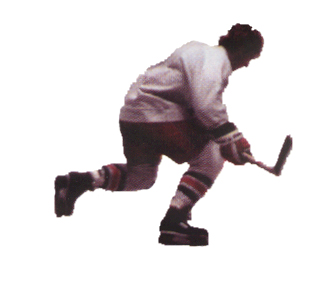Strength Training In Hockey
 In the game of hockey a player that is strong in the weight room is not necessarily a strong player on the ice. To be a factor on the ice depends on a solid base from the legs up. Although upper body strength is required, the real base of support starts in the legs, and midline muscles.
In the game of hockey a player that is strong in the weight room is not necessarily a strong player on the ice. To be a factor on the ice depends on a solid base from the legs up. Although upper body strength is required, the real base of support starts in the legs, and midline muscles.
 Case in point is the European player who has the slim upper body physique. Even though his competitor can usually out bench him or out curl him in the weight room, he is hard pressed to knock him off the puck, even though his upper body strength is superior. The European player has total body hockey specific strength.
Case in point is the European player who has the slim upper body physique. Even though his competitor can usually out bench him or out curl him in the weight room, he is hard pressed to knock him off the puck, even though his upper body strength is superior. The European player has total body hockey specific strength.
 A strong hockey player is one who can skate through sticks, score goals when a defender is hanging on him, knock people down, and sometimes even wrestle an opponent to the ice during an altercation.
A strong hockey player is one who can skate through sticks, score goals when a defender is hanging on him, knock people down, and sometimes even wrestle an opponent to the ice during an altercation.
 It has become common to think that a strong player is one who can bench press a lot of weight. Actually power is the product of both force and speed. A workout may involve exercises that have nothing to do with weights. In the last ten years, players and coaches may have over-rated the place of weight training in the development
It has become common to think that a strong player is one who can bench press a lot of weight. Actually power is the product of both force and speed. A workout may involve exercises that have nothing to do with weights. In the last ten years, players and coaches may have over-rated the place of weight training in the development
of hockey players, almost to the point that when one mentions "work out," people assume your talking about weight training.
 Applied Hockey Science emaphasizes strength training programs that focus on athletisicm, and sport specific strength as it relates to the game of hockey. This in turn produces hockey players that are faster, stronger, and more agile on the ice.
Applied Hockey Science emaphasizes strength training programs that focus on athletisicm, and sport specific strength as it relates to the game of hockey. This in turn produces hockey players that are faster, stronger, and more agile on the ice.

